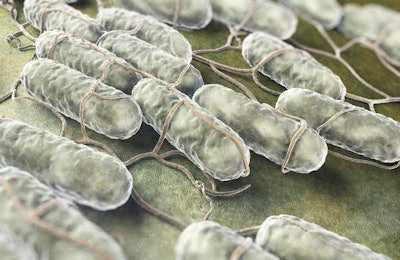
Salmonella is a persistent food safety risk the poultry industry is trying to control in every step from hatching to processing. One potential infection route worth considering is the airborne route.
Salmonella in dust during growout
Salmonella can be spread throughout the litter in a broiler house by several mechanisms including insects, such as flies or darkling beetles, and broiler fecal shedding. The bacteria is then transmitted to broilers through physical contact and ingestion. An additional route of contamination is the presence of Salmonella on dust inhaled by the birds.
There’s a high variability of the levels of dust present in a broiler house. A wide range of dust concentrations from 0.03 to 6.5 milligrams per cubic meter is influenced by everything from the time of day to the house ventilation differences based on outside temperatures to the levels of bird activity in the house.
Broiler house dust contains a mixture of dander, litter, feed, feces, and microbes, with the vast majority of dust containing microbial DNA. Broilers inhaling dust contaminated with Salmonella are a potential route of both bird contamination and subsequent fecal shedding once colonization occurs.
How Salmonella infects birds through the trachea
Several studies demonstrated inoculating broilers with Salmonella within the trachea leads to further intestinal colonization. There is also evidence that the rate of colonization from birds inoculated in the trachea is greater than if birds are orally inoculated.
When comparing five inoculation routes – oral, intra-tracheal, subcutaneous, ocular, and cloacal – the intra-tracheal inoculation route led to intestinal tract colonization significantly more frequently than all other routes. In turkeys exposed to Salmonella contaminated fecal dust, Salmonella was detected from respiratory tract samples, lungs, and small intestines.
The transfer of Salmonella from the litter or house dust to the respiratory tract (specifically the trachea) may influence the colonization of the bacteria within the birds and the distribution of Salmonella through the flock.
Harvest dust and Salmonella
The presence of dust may also have further impact in the processing plant on broiler product Salmonella status.
Generally, catch crew workers wear respiratory protective equipment during harvest (catching) to minimize the amount of dust they inhale. However, the birds themselves do not have any external respiratory protection other than the increased mechanical exhaust ventilation during harvest. Therefore, there is potential for increased levels of dust in the air to be inhaled by the broilers during catching and accumulate in the respiratory tract.
The levels of dust present during catching may depend on the outside ambient temperature. During hot weather, ventilation rates are at maximum levels to prevent bird heat stress. However, during cold weather ventilation rates are at lower levels to prevent bird chilling. This difference in ventilation could impact levels of dust present during broiler catching.
Although it would seem increased ventilation would decrease dust, it is possible increased ventilation rates combined with increased bird activity during harvest may cause resuspension of dust particles. Research shows that greater levels of E. coli were detected in air from tunnel ventilated broiler houses during the summer when ventilation rates were higher in comparison to lower winter ventilation rates.
Research on tracheal response to bacterial infection
In a study where broiler respiratory tracts were sampled one week prior to harvest, one day prior to harvest, and during harvest there was a trend of decreasing Salmonella and Enterobacteriaceae prevalence even during catching when dust levels were expected to be higher than normal.
This decrease in respiratory tract bacteria was unexpected considering the increases in dust during harvest. The mucus and cilia lining the trachea are continuously removing dust particles, bacteria, and toxins from the air where they are swallowed and enter the esophagus. This mucus coating may aid the passage through the acid environments of the proventriculus and gizzard of young chicks and result in intestinal colonization.
An in vitro tracheal clearance assay reported a clearance velocity of 2.39 millimeters per minute for chicken embryos. Using this clearance rate, the entire broiler trachea would clear every 1.05 minutes. Tracheal clearance of dust inhaled during catching may have led to the general decrease in respiratory tract bacteria during harvest.
Conclusion
The broiler respiratory tract appears to be an important potential route for Salmonella dissemination in a growout house. However, the exposure of broilers to dust during harvest may not lead to significant levels of carcass contamination. Based on this information, steps to minimize the presence of dust during the growout period could potentially decrease levels of Salmonella contamination within the house and therefore decrease the levels of Salmonella entering the processing plant.
References available on request
Read more:
3 tools to control reactivated Salmonella in poultry feed, www.WATTAgNet.com/articles/32337
broiler-catch-crew-dust.jpg
Caption: During broiler harvest there is often an increase in the levels of dust in the air. | Dianna Bourassa
Salmonella-recovery-from-multiple-inoculation-routes
Salmonella is found at the highest percentage when broilers are inoculated in the trachea
Respiratory-Salmonella-recovery-during-harvest
Exposure to dust during harvest does not increase Salmonella prevalence
















